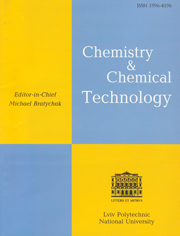Improved Method for Determining Microbiological Contamination of Fatty Acid Methyl Esters and Blended Diesel Fuels
| Attachment | Size |
|---|---|
| 345.38 KB |
[1] Patrylak, L.; Patrylak, K.; Okhrimenko, M.; Zubenko, S.; Levterov, A.; Savytskyi, V. Comparison of Power-Ecological
Characteristics of Diesel Engine Work on Mixed Diesel Fuels on the Basis of Ethyl Esters of Rapeseed and Sunflower Oils. Chem. Chem. Technol. 2015, 9, 383−390. https://doi.org/10.23939/chcht09.03.383
https://doi.org/10.23939/chcht09.03.383
[2] Maymuchar; Wirahadi, D.; Faturrahman, N.A.; Febria, M.; Hanifuddin, M.; Aisyah, L.; Supriadi, F.; Bethari, S.A.; Karina, R.M.; Rulianto, D. et al. The Effect Characteristics Cetane Number of Commercial High-Speed Diesel Fuel-Biodiesel Palm Oil-Based Blends on CFR engine. IOP Conference Series: Earth and Envi-ronmental Science 2022, 1034, 012044. https://doi.org/10.1088/1755-1315/1034/1/012044
https://doi.org/10.1088/1755-1315/1034/1/012044
[3] Wu, G.; Ge, J.C.; Choi, N.J. A Comprehensive Review of the Application Characteristics of Biodiesel Blends in Diesel Engines. Appl. Sci. 2020, 10, 8015. https://doi.org/10.3390/app10228015
https://doi.org/10.3390/app10228015
[4] Sorate, K.A.; Bhale, P.V. Biodiesel Properties and Automo-tive System Compatibility Issues. Renew. Sust. Energ. Rev. 2015, 41, 777−798. https://doi.org/10.1016/j.rser.2014.08.079
https://doi.org/10.1016/j.rser.2014.08.079
[5] Passman, F.J. Microbial Contamination and its Control in Fuels and Fuel Systems Since 1980 - A Review. Int. Biodeterior. Biodegradation 2013, 81, 88-104. https://doi.org/10.1016/j.ibiod.2012.08.002
https://doi.org/10.1016/j.ibiod.2012.08.002
[6] Matveeva, E.; Vasylchenko, A.; Demianko, D. Mikrobiolohi-cheskoe porazhenie aviatsionnykh topliv. Systemy ozbroiennia i viiskova tekhnikа 2011, 26, 152−156.
[7] Shkilniuk, І. Books of Abstracts, 1st International Symposium on Sustainable Aviation, Istanbul, Turkey, 31 May-3 June 2015.
[8] Onuorah, S.; Obika, I.; Orji, M.; Odibo, F. Microbial Conta-minants in the Commercial Aviation Fuel Obtained from Benin City Airport, Nigeria. Univers. J. Microbiol. Res. 2015, 3, 31−35. https://doi.org/10.13189/UJMR.2015.030301
https://doi.org/10.13189/ujmr.2015.030301
[9] Lugauskas, A.; Prosychevas, I.; Levinskaitė, L.; Jaskelevičius, B. Physical and Chemical Aspects of Long-Term Biodeterioration of Some Polymers and Composites. Environ. Toxicol. 2004, 19, 318-328. https://doi.org/10.1002/tox.20028
https://doi.org/10.1002/tox.20028
[10] Rauch, M.E.: Graef, H.W.; Rozenzhak, S.M.; Jones, S.E.; Bleckmann, C.A.; Kruger, R.L.; Naik, R.R.; Stone, M.O.
[11] Characterization of Microbial Contamination in United States Air Force Aviation Fuel Tanks. J. Ind. Microbiol. Biotechnol. 2006, 33, 29-36. https://doi.org/10.1007/s10295-005-0023-x
https://doi.org/10.1007/s10295-005-0023-x
[12] Abbasian, F.; Lockington, R.; Mallavarapu, M.; Naidu, R. A Comprehensive Review of Aliphatic Hydrocarbon Biodegradation by Bacteria. Appl. Biochem. Biotechnol. 2015, 176, 670-699. https://doi.org/10.1007/s12010-015-1603-5
https://doi.org/10.1007/s12010-015-1603-5
[13] Imron, M.F., Kurniawan, S.B., Titah, H.S. Potential of
Bacteria Isolated from Diesel-Contaminated Seawater in Diesel Biodegradation. Environ. Technol. Innov. 2019, 14, 100368. https://doi.org/10.1016/j.eti.2019.100368
https://doi.org/10.1016/j.eti.2019.100368
[14] Fathepure, B.Z. Recent Studies in Microbial Degradation of Petroleum Hydrocarbonsin Hypersaline Environments. Front. Microbiol. 2014, 5, 173. https://doi.org/10.3389/fmicb.2014.00173
https://doi.org/10.3389/fmicb.2014.00173
[15] Polutrenko, M.; Pilyashenko-Novokhatnyi, A. Effect of
Nitrogenated Corrosion Inhibitors on the Growth and Ferment Activity of Sulfur Cycle Bacteria. Chem. Chem. Technol. 2013, 7, 471-475. https://doi.org/10.23939/chcht07.04.471
https://doi.org/10.23939/chcht07.04.471
[16] Franco-Duarte, R.; Černáková, L.; Kadam, S.; Kaushik, K.S.; Salehi, B.; Bevilacqua, A.; Corbo, M.R.; Antolak, H.; Dybka-Stępień, K.; Leszczewicz, M. et al. Advances in Chemical and Biological Methods to Identify Microorganisms-From Past
to Present. Microorganisms 2019, 7, 130. https://doi.org/10.3390/microorganisms7050130
https://doi.org/10.3390/microorganisms7050130
[17] Boichenko, S.V.; Shkilniuk, I.O.; Novak, A.O. Metodyka vyznachennia mikrobiolohichnoho zabrudnennia aviatsiinykh palyv. Ukraine 94190, October 10, 2014.
[18] Kumar, A.; Murthy, L.N.; Jeyakumari, A.; Laly, S.J. Sterilization Technique Used in Microbiology. In Microbiological Examination of Seafood Pathogens; Kumar, A.; Murthy, L.N.; Jeyakumari, A.; Laly, S.J., Eds.; Mumbai Research Centre of ICAR- Central Institute of Fisheries Technology, Vashi, India, 2019; pp 3-5.
[19] Das, D. Essential Practical Handbook of Cell Biology & Genetics, Biometry & Microbiology; Academic Publishers: Kolkata, 2017.
[20] Madison, B.M. Application of Stains in Clinical Microbiolo-gy. Biotech. Histochem. 2001, 76, 119-125 https://doi.org/10.1080/bih.76.3.119.125
https://doi.org/10.1080/bih.76.3.119.125
[21] Ali-Shtayeh, M. S. A.; Jamous, R. M.; Yaghmour, R. M. Mycology Manual; National University: Nablus, Palestine, 2013.
[22] Bücker, F.; de Moura, T.M.; da Cunha, M.E.; de Quadros, P.D.; Beker, S.A.; Cazarolli, J.C.; Caramão, E.B.; Frazzon, A.P.G.; Bento, F.M. Evaluation of the Deteriogenic Microbial Community Using qPCR, n-Alkanes and FAMEs Biodegradation in Diesel, Biodiesel and Blends (B5, B10, and B50) During Storage. Fuel 2018, 233, 911-917. https://doi.org/10.1016/j.fuel.2017.11.076
https://doi.org/10.1016/j.fuel.2017.11.076
[23] Altaie, M.A.H.; Janius, R.B.; Yunus, R.; Taufiq-Yap, Y.H.; Zakaria, R. Degradation of Enriched Biodiesel under Different Storage Conditions. Biofuels 2017, 8, 181-186. https://doi.org/10.1080/17597269.2016.1215070
https://doi.org/10.1080/17597269.2016.1215070










